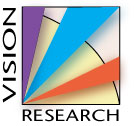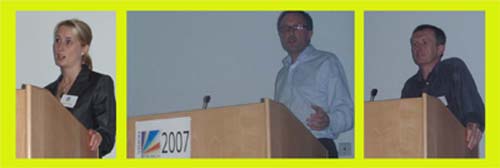


Investigators and Projects
In the course of the day, the speakers at Vision Research 2007 covered exciting new work in development, genetics and inflammation. We started with a review, by Dr. Vanessa Davies, of the role of inherited mitochondrial defects in the pathogenesis of inherited optic neuropathies. Dr. Davies described the detailed analysis of mutations of two genes, OPA-1 and OPA-3, which have been implicated in optic atrophy. Dr. James Morgan then gave an overview of the effects of glaucoma on the dendritic tree of retinal neurones. He presented evidence to support the thesis that retinal cells, which have been damaged by increased intra-ocular pressure, may retain the potential to recover function.
Following coffee, Professor Graeme Black from Manchester, discussed his studies of mutations of bestrophin, a protein that is important in the function of the retinal pigment epithelium. His exciting presentation explored the different clinical syndromes that were associated with specific bestrophin mutations, arguing that there were at least three diseases of the eye that were all manifestations of different bestrophin mutations. Dr. Eric Mayer then presented new work in the area of bioelectronics, with specific attention to its application in providing successful visual prostheses. The morning finished with an outstanding example of the integration of cellular and molecular medicine, with simple clinical observation, to translate research from the bench to the patient. Professor Peng Khaw recounted how completing this virtuous circle has been shown to reduce specific surgical complications forty fold.

In the afternoon, the focus of attention moved to inflammation, with the presentation of new work from Bristol investigating the dynamics of autoimmune ocular inflammation and the role of inhibitor molecules such as CD200 in controlling macrophage induced disease. This was followed by a description by Professor Andrew George of work in his group, exploiting the immunoregulatory action of indole 2,3-dioxygenase to modify corneal graft rejection.
The day finished with three outstanding lectures, first an overview of the role of defensins in ocular infection, given by Professor Harminder Dua, stressing the important role that these short peptides play in disease. Then, a masterful review of the role of complement in eye disease, given by Professor Paul Morgan from Cardiff. Professor Morgan presented new data emphasising the importance of complement as an amplifier of inflammation in uveitis, and addressed the recent discoveries that relate polymorphisms of factor H to age-related macular degeneration (AMD). Professor John Forrester then supplemented this with an elegant exploration of the role of activated macrophages in AMD, bringing together a number of observations that point to a role for the recruitment of macrophages in normal and abnormal homeostasis of the retinal pigment epithelium.
